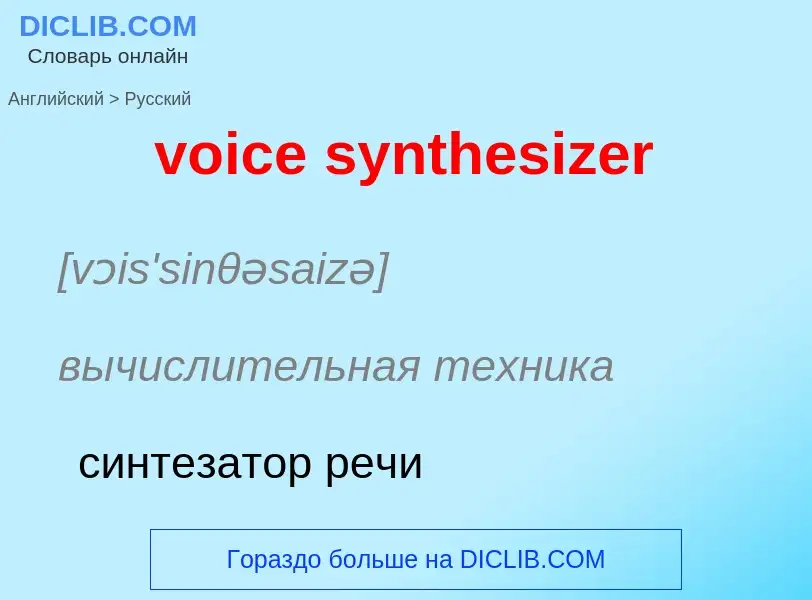Tradução e análise de palavras por inteligência artificial ChatGPT
Nesta página você pode obter uma análise detalhada de uma palavra ou frase, produzida usando a melhor tecnologia de inteligência artificial até o momento:
- como a palavra é usada
- frequência de uso
- é usado com mais frequência na fala oral ou escrita
- opções de tradução de palavras
- exemplos de uso (várias frases com tradução)
- etimologia
voice synthesizer - tradução para russo
[vɔis'sinθəsaizə]
вычислительная техника
синтезатор речи
аппарат искусственной речи
общая лексика
синтез речи
синтез речи компьютером по текстовому файлу или фонетическому описанию
синоним
Смотрите также
Definição
Wikipédia
Speech synthesis is the artificial production of human speech. A computer system used for this purpose is called a speech synthesizer, and can be implemented in software or hardware products. A text-to-speech (TTS) system converts normal language text into speech; other systems render symbolic linguistic representations like phonetic transcriptions into speech. The reverse process is speech recognition.
Synthesized speech can be created by concatenating pieces of recorded speech that are stored in a database. Systems differ in the size of the stored speech units; a system that stores phones or diphones provides the largest output range, but may lack clarity. For specific usage domains, the storage of entire words or sentences allows for high-quality output. Alternatively, a synthesizer can incorporate a model of the vocal tract and other human voice characteristics to create a completely "synthetic" voice output.
The quality of a speech synthesizer is judged by its similarity to the human voice and by its ability to be understood clearly. An intelligible text-to-speech program allows people with visual impairments or reading disabilities to listen to written words on a home computer. Many computer operating systems have included speech synthesizers since the early 1990s.
A text-to-speech system (or "engine") is composed of two parts: a front-end and a back-end. The front-end has two major tasks. First, it converts raw text containing symbols like numbers and abbreviations into the equivalent of written-out words. This process is often called text normalization, pre-processing, or tokenization. The front-end then assigns phonetic transcriptions to each word, and divides and marks the text into prosodic units, like phrases, clauses, and sentences. The process of assigning phonetic transcriptions to words is called text-to-phoneme or grapheme-to-phoneme conversion. Phonetic transcriptions and prosody information together make up the symbolic linguistic representation that is output by the front-end. The back-end—often referred to as the synthesizer—then converts the symbolic linguistic representation into sound. In certain systems, this part includes the computation of the target prosody (pitch contour, phoneme durations), which is then imposed on the output speech.

![Computer and speech synthesizer housing used by [[Stephen Hawking]] in 1999 Computer and speech synthesizer housing used by [[Stephen Hawking]] in 1999](https://commons.wikimedia.org/wiki/Special:FilePath/Computer and speech synthesiser housing, 19 (9663804888).jpg?width=200)
.png?width=200)

![[[Stephen Hawking]] was one of the most famous people to use a speech computer to communicate. [[Stephen Hawking]] was one of the most famous people to use a speech computer to communicate.](https://commons.wikimedia.org/wiki/Special:FilePath/Stephen Hawking.StarChild.jpg?width=200)
